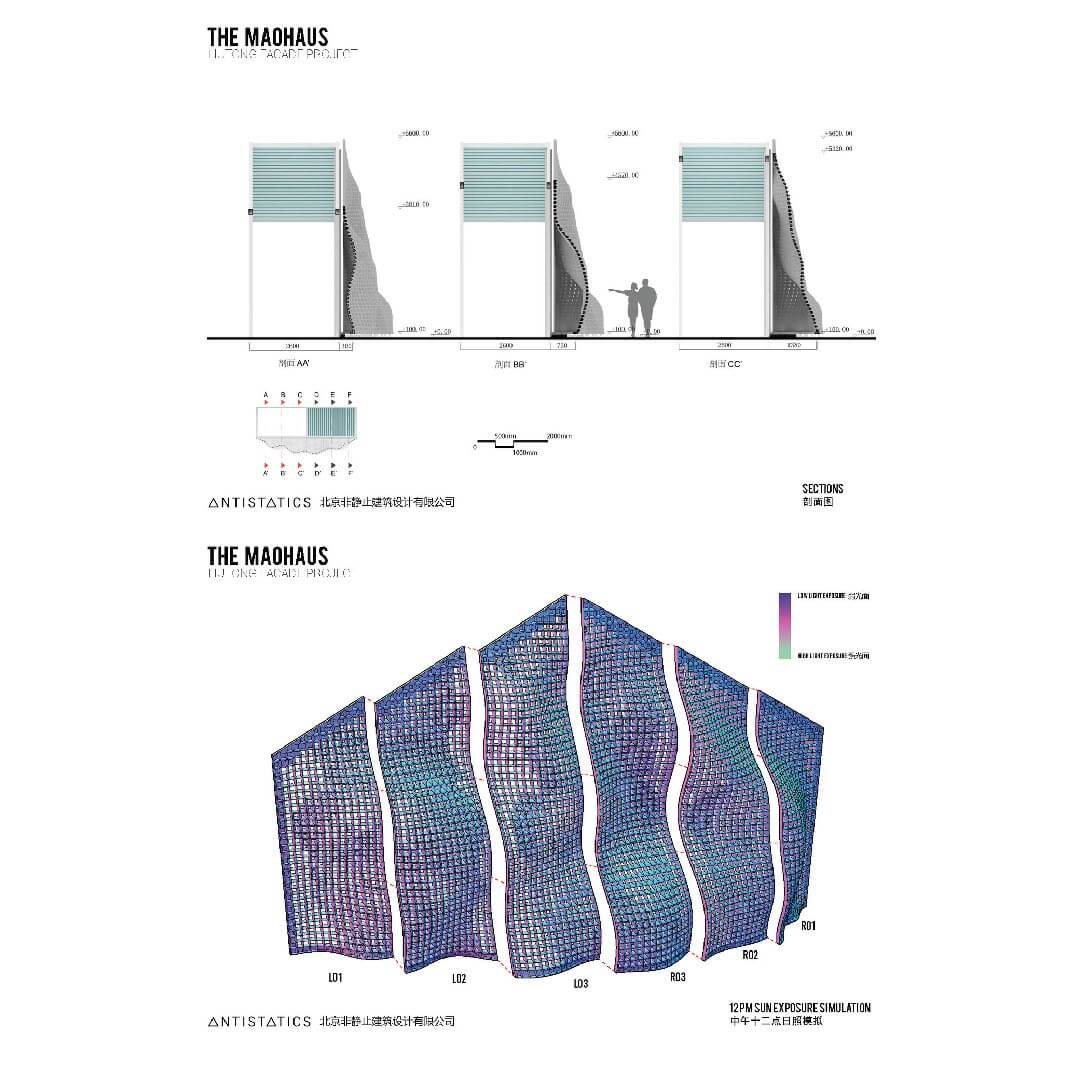The MaoHaus
The MaoHaus
AntiStatics Architecture
MaoHaus is an experimental façade piece exploring historical context, material potentials, novel fabrication and performative qualities within architecture.
 Taking the simple frame and edge condition of the existing structure, the façade enters the space of the hutong as a flowing fabric.
Taking the simple frame and edge condition of the existing structure, the façade enters the space of the hutong as a flowing fabric.
 This fluidity is expressed through the conventionally rigid material of concrete questioning inherent perceptions of materiality through formal expression.
This fluidity is expressed through the conventionally rigid material of concrete questioning inherent perceptions of materiality through formal expression.
 Beyond the undulating form, the perforations of the surface serve to filter light, during the day, rays of sunlight enter the vestibule, and at night the precisely tuned apertures reveal a triptych of Chairman Mao’s prototypical portrait.[1]
Beyond the undulating form, the perforations of the surface serve to filter light, during the day, rays of sunlight enter the vestibule, and at night the precisely tuned apertures reveal a triptych of Chairman Mao’s prototypical portrait.[1]
 The expression of Chairman Mao within the façade is a nod to the historical context of the site. The work is located in a Hutong alley in central Beijing adjacent to The People’s Art House Print Shop, this workshop was once one of the primary producers of the Chairman’s now iconic image.[2]
The expression of Chairman Mao within the façade is a nod to the historical context of the site. The work is located in a Hutong alley in central Beijing adjacent to The People’s Art House Print Shop, this workshop was once one of the primary producers of the Chairman’s now iconic image.[2]
 The six concrete panels of seven centimeters that cover the facade with the portrait of Mao Zedong were designed using fluid dynamics algorithms to optimize the transport of loads.[3]
The six concrete panels of seven centimeters that cover the facade with the portrait of Mao Zedong were designed using fluid dynamics algorithms to optimize the transport of loads.[3]
 Made of Ultra-High Performance Concrete, the six individual parts of the façade stand without the need of any substructure for support. Each panel has been cast as a single unit from large CNC milled moulds.
Made of Ultra-High Performance Concrete, the six individual parts of the façade stand without the need of any substructure for support. Each panel has been cast as a single unit from large CNC milled moulds.
 The undulating curve of each piece was computationally generated through fluid-dynamics algorithms and works to more efficiently carry the load of the façade to the foundation.
The undulating curve of each piece was computationally generated through fluid-dynamics algorithms and works to more efficiently carry the load of the façade to the foundation.
 As well as allowing daylight to pour into the building beyond and reducing the weight of typically hefty concrete, the slotted openings spread across the surface of the concrete are actually precisely patterned.
As well as allowing daylight to pour into the building beyond and reducing the weight of typically hefty concrete, the slotted openings spread across the surface of the concrete are actually precisely patterned.
 By night the apertures cut a figure of the iconic Chairman Mao propaganda poster. This is a subtle reference to the history of the site: The MaoHaus is located in a hutong just next-door to a workshop formerly known as The People’s Art House Print Shop, the primary producers of the Mao portrait.[4]
By night the apertures cut a figure of the iconic Chairman Mao propaganda poster. This is a subtle reference to the history of the site: The MaoHaus is located in a hutong just next-door to a workshop formerly known as The People’s Art House Print Shop, the primary producers of the Mao portrait.[4]
 The MaoHaus / AntiStatics Architecture / https://www.archdaily.com/886282/the-maohaus-antistatics-architecture ↑
The MaoHaus / AntiStatics Architecture / https://www.archdaily.com/886282/the-maohaus-antistatics-architecture ↑- “THE MAOHAUS” 16 BanQiao Hutong Façade / https://www.antistatics.net/maohaus ↑
- The MaoHaus, Beijing / https://arquitecturaviva.com/works/the-maohaus-beijing ↑
- The MaoHaus in Beijing, China by AntiStatics Architecture. / https://www.yellowtrace.com.au/maohaus-beijing-antistatics-architecture/ ↑




























Comments